
|   |

|   |
Vempati's Chandalika: Old wine in new bottle - Prof. Dr. Sruti Bandopadhay e-mail: srutibandopadhay2@gmail.com Photos: N. Ravi Kumar (Oneglint) May 23, 2023 Abhinaya Vani Nritya Niketan (est. 2009), Hyderabad, celebrated the birthday of Tagore on May 7, 2023 with the production Chandalika, originally written by Gurudev Rabindranath Tagore, scripted in Telugu by Bhujangaraya Sarma. The music was conceptualized and composed by K. Mallikarjun Rao and the original choreography by Guru Vempati Chinna Satyam, who first composed it to commemorate the birth centenary of Rabindranath Tagore in 1961 and was performed by students of Kavali College. Since then this choreography has been performed for more than hundred times. Many remember Sobha Naidu's depiction of Prakriti creating overwhelming response in the audience. During the 150 years of celebration of Tagore's birthday, the Department of Dance, Sarojini Naidu School of Arts and Communication, University of Hyderabad, produced Chandalika under the leadership of Vempati's able disciple Prof. Dr. Anuradha Jonnalagadda. On the other hand, Vempati's institution Kuchipudi Art Academy has been regularly performing Chandalika in India and abroad. With so many disciples of the master preferring to stage the dance drama and the huge response it gains from the audience, Vempati Chinna Satyam's choreography has stood the test of time and emerged as an ageless choreography in Kuchipudi repertoire. Chavali Bala Tripura Sundari, the daughter of Guru Vempati Chinna Satyam, directed the dance drama keeping the flavors of the original choreography and presenting it almost without any alterations. Chandalika has always been a favorite with many dancer-choreographers for its timeless message of equality and self-consciousness that is still relevant in today's society. 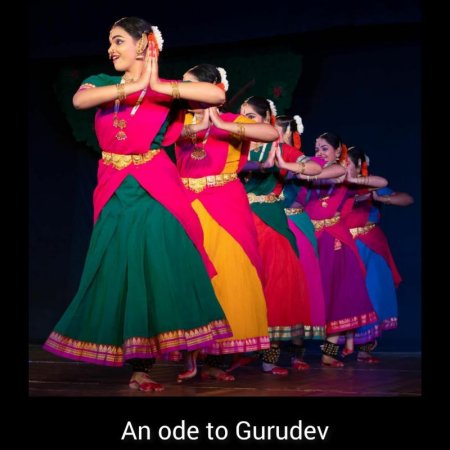
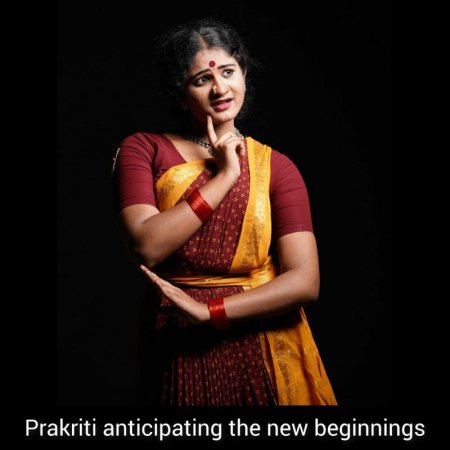
The script by Sarma had the flavor of the original sahitya of Tagore and the re-creation cast a magnetic spell on the audience. Chandalika, who is called Prakriti, is truly a constituent of Nature as she says in the original dance drama, 'phul bole dhanya ami, matir pore' (the flower says that I am blessed to be on the ground). Sarma beautifully explored this character, where the girl from the untouchable community tries to live as a human being but is constantly red baited by the upper class people and puts her to question her individuality in the society. In the original text Tagore has put the characters doiwala or the curd seller and the churhiwala or the bangle sellers for the drama structure. The upper-class women oppress Chandalika and do not let her buy the curd or the bangles, as she is low caste and untouchable. Interestingly, Sarma has included the flower sellers as the third option for the drama, which suggests his uniqueness in dealing with the theme. First, in the south, the selling and buying of flowers is a most common experience in the community, so it became easy for the indigenous people of the region to identify their daily experience in the drama. Secondly the flower has a unique place in the original dance drama of Tagore, where the drama starts with the advent of spring and the basket full of flowers, as also identifying Prakriti with the freshness of flowers and its recognition as the root to the mother earth. Hence Sarma giving importance to flower sellers and buyers give a wide range of interpretation to this valuable inclusion. Bhuvana Reddy and Sahana Reddy enacted the flower sellers here. Also, the doiwala and the churhiwala are male characters and danced solos in the original drama, but for Sarma they are females and in groups, as South India have females selling milk and bangles. 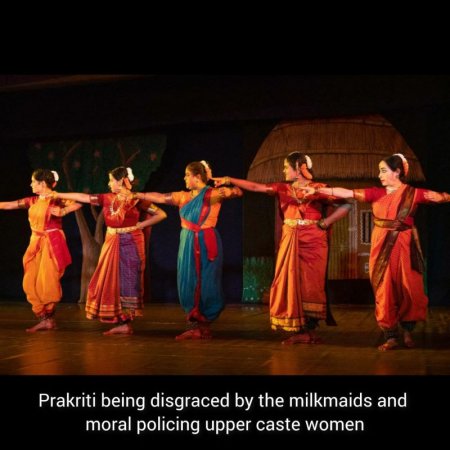

Guru Vempati Chinna Satyam while interpreting this in his drama has taken the age of the three groups as teenagers, young women and middle-aged women. Again, throwing of curd and stones to the untouchable may be the actual treatment seen in villages, but in the original, Tagore had not included such elucidation. In Tagore's aesthetic, such realistic depiction is hardly observed. However, the form Kuchipudi and Yakshagana, have immense folk flavor. This gave the choreographer justifiable scope for these depictions and convincingly suited the performance here. Prasuna Nuti, Ramani Siddhi and Sasi Challa Tadepalli danced the milk sellers and Sriya Akila, Vaishnavi Yellapragada and Nibadita VRK danced the bangle sellers for this performance. The upper caste women were Priyahasini Mandava and Anuritha. The music by Mallikarjuna Rao ought to be appreciated for its scores of dimensions. The application of various Hindusthani tunes is a milestone in the Carnatic music world. Rao, famous for his light music compositions in Karnataka, has utilized several folk and light classical genres for the composition of this production. The production started with a traditional tribute to Tagore with the beginning line "Jaya jaya Rabindra kavita, galamalika Chandalika" danced by Priyahasini Mandava, Anuritha, Sahana Jaykrishna, Yagna Shikha, Sanjana Kotipalli, and Leela Manaswini. The rhythmic structure also had variation and combination of different instruments. The outsourcing of the tabla alongside the traditional mridangam of Kuchipudi, created a unique rhythmic impression that made the audience enjoy every bit of the music. The accompanying artistes in the live orchestra were DSV Sastry, whose immense involvement in the singing was the most effective mood maker. Mrudu Ravali Darbha, a young talented vocalist from a traditional family struck the notes of emotion with her completely tuned vocals as also helped the dancers to emote with confidence and grace. The other accompanists Rajagopalachary on mridangam, Dinakar on violin, VBS Murali on flute and Rayaprolu Sudhakar on veena brought out the colors of the music compositions. Bala, herself in the nattuvangam conducted the show with confidence and ease. The dance part of the choreography borrowed multiple aspects of the traditional Yakshaganam, from darus and samvadas to padyams and vachanams while portraying all his signature features like elaborate aharya and intricate angikabhinaya. He tailored the story and its presentation to suit the Telugu countryside folk culture. Following her father's choreography, Bala, who is a teacher of excellence, trained her students at the institute Abhinaya Vani Nritya Niketan, and came up with high standard of dance sequences. It is interesting to know that Bala was never encouraged to become a dancer by her father, but she pursued her father's vision and creation and is at present a dedicated teacher of her father's lineage settled in Hyderabad. Kudos to her for being an example of dedication to preservation and propagation of her father's work! 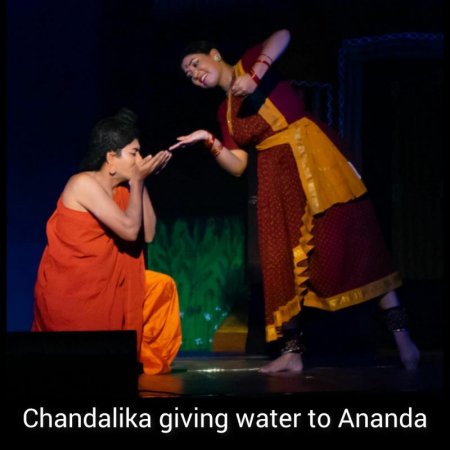
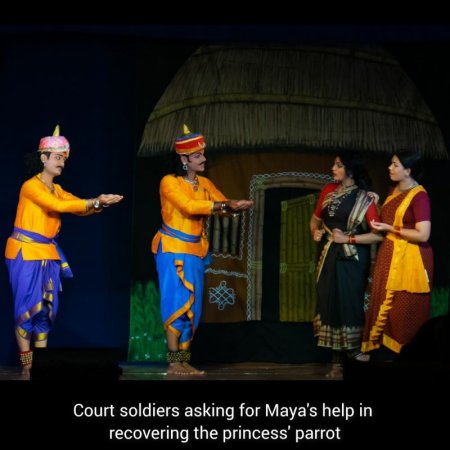
The story Chandalika, when adopted for the Telugu community through the traditional dramas like the Yakshagana and Kuchipudi, saw remarkable distinctive features of Telugu culture in presentation. At the beginning, six girls in traditional nanga-oni (skirt and scarf) perform the invocation to Tagore. The traditional mode adapted a contemporary story in its periphery. The yati-s or the rhythmic patterns used in-between the lines of a song reminded one of how Tagore, while composing dances on his songs has approved the use of the bols or the tala patterns in-between his lines. Indian classical dances are ornamented with nritta or the pure dance movements on tala and nritya or the dances based on the bhava or the emotions. This had been the tradition. Hence in Tagore's idiom of dance the combination of these two are observed, which adheres to the traditional structure of our country. 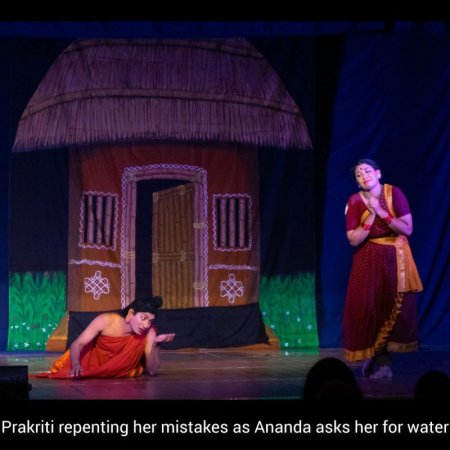
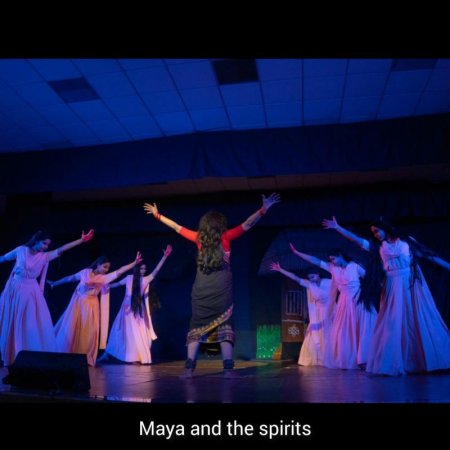
A splendid choreography of the visualization of the curd sellers walking down the streets to sell curds is observed. Prakriti following them from behind and finally asking for curd made a good impact. Dialogues between Prakriti and the curd sellers are convincing. The entrance of Ananda as a thirsty man is poles apart from what we witness in Tagore's dance drama. The Buddhist monk, with all the dignity of the preacher, the calm and restrained persona would slowly walk to the untouchable girl and request for water. But Vempati visualized gestures of tiredness and walks with imbalance in feet for Ananda, which brought about a feeling of worry and tension. On such urgent situation of the need of water, Prakriti repudiates to offer water. The situation becomes extremely overwrought. In such situation, the realization of self by Prakriti as part of the humankind evoked intense feelings. As Prakriti offered water, the flow of the water made the situation dissolve into a magical bliss. The following dance depicted the new birth of Prakriti, the navajivana, the navajagriti. The syllable compositions touched the highest level of compositions. Sowmya, dancing as Chandalika won the hearts of all with her excellent depiction of the character, Pasumarthy Mrityunjay Sharma as Ananda portrayed truthfully. Madhurapantula Sita Lakshmi Prasad as Maya put in all effort for the character. The group dance for the spirits is another dance of exceptional compositions with yati-s blending perfectly into the songs and dance compositions requiring good finesse. Bhuvana, Sahana, Sriya, Vaishnavi, Sanjana and Bijina Balakrishna danced in coordination. The spirits wore peach-pink costumes and had long open flowing hair. Surabhi Kishore was on lights, which was mediocre because of the stage setting. Ashok Bhupati took the responsibility of makeup and costume, which again had the stamp of the earlier production. 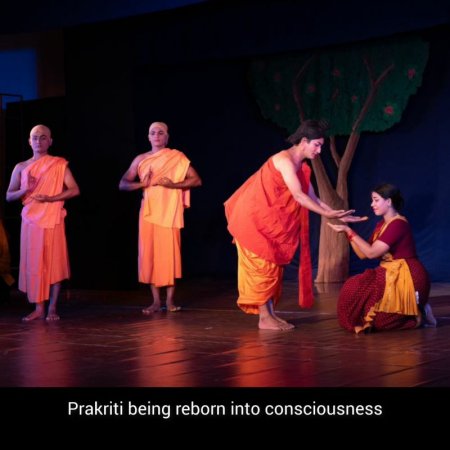 On the whole the evening came out successfully primarily for the intense dedication of Chavali Bala Tripura Sundari and all the artistes of the institute. The superb accompaniment gave the necessary boost to the production. 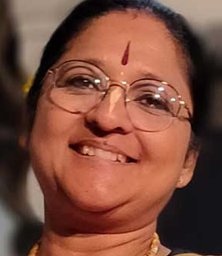 Prof. Dr. Sruti Bandopadhay is a rare combination of dancer-scholar having been awarded the Akademi Puraskar by Sangeet Natak Akademi in 2020. She is a 'Top' Grade in Manipuri dance by Doordarshan and is at present a Professor in Manipuri dance in Visva Bharati, Santiniketan. She is the recipient of the Fulbright Fellowship, the Commonwealth Fellowship for teaching and performing in the US and the UK respectively. She is awarded the DLitt in Manipuri Dance from Visva Bharati. She regularly performs, lectures and writes. She has five books and many articles on dance to her credit. |